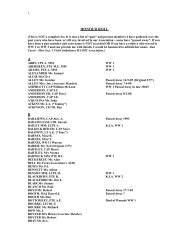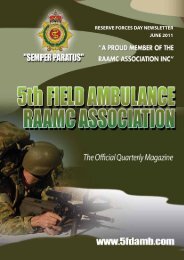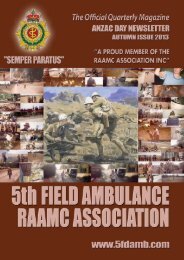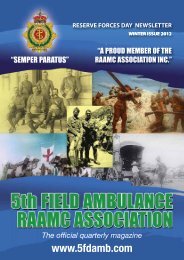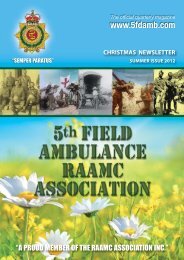2010 Paulatim Magazine - RAAMC Association
2010 Paulatim Magazine - RAAMC Association
2010 Paulatim Magazine - RAAMC Association
You also want an ePaper? Increase the reach of your titles
YUMPU automatically turns print PDFs into web optimized ePapers that Google loves.
The Next Step for Australian Army Medics<br />
A Physician Assistant (PA) is defined as a “midlevel health care<br />
practitioner working under the delegated authority of a medical<br />
practitioner”. 1 The PA profession has developed over several decades<br />
in the US and proven to be successful in augmenting the medical<br />
workforce and addressing geographical inequities in the provision of<br />
health services. Such outcomes have been mirrored more recently in<br />
Canada and the UK. 2,3 No framework currently exists for Medics<br />
however to upskill.<br />
The wheels are starting to turn in regards to the acceptance and<br />
integration of PA into the Australian health system. Australian health<br />
policy makers have looked to emulate the success of PA overseas by<br />
developing our own PA profession. The South Australian and<br />
Queensland health departments have conducted recent trials on the use<br />
of overseas trained PA in their public hospitals. 4,5 A review of these<br />
trials is underway with the prospect of PA professional recognition and<br />
employment in these states a genuine possibility.<br />
PA could play a valuable role in the Army’s health system, providing<br />
accreditation for medics in their own right, upskill medics for key<br />
functions in the fighting echelons, replace MO and providing the ability<br />
for medics to clinically up-skill. A review of the current training<br />
continuum for Australian Army medics and opportunities for ongoing<br />
professional development is in order. In early 2009, a new structure for<br />
training medics to the level of Advanced Medical Technician (AMT) was<br />
instituted. A medics formal training is complete after the Advanced<br />
Medical Assistant Course. AMTs are then posted to units to begin their<br />
career as medics. 6<br />
Once a medic has completed AMAC and become an AMT, further<br />
medical training options for medics are very limited. Few positions are<br />
available for medics to up-skill. Opportunities include ADF courses such<br />
as Rotary Wing Aeromedical Evacuation (RWAME) training, Fixed Wing<br />
Aeromedical Evacuation Training, Underwater Medicine and Aviation<br />
Medicine, placements in public hospitals through ‘strategic alliance’<br />
agreements. Once a medic moves into senior positions as a SGT or WO,<br />
they take on a management and training role, with little need to either<br />
utilise or develop their clinical skills. It is at this point that many senior<br />
medics, some of the Corps’ most experienced and capable members,<br />
feel they need to make a decision regarding their future prospects –<br />
stay in the Army to mentor and manage junior medics as a WO or<br />
ASWOC, or leave the army to pursue professional development in the<br />
civilian healthcare sector.<br />
This latter option generally involves further formal studies and with<br />
their associated sacrifices. Popular study choices for medics leaving the<br />
army include nursing, paramedical science or medicine. Others who<br />
choose not to go on to other studies may find work as medics on a<br />
contract basis with mining companies or on oil rigs. Employment in<br />
public health organisations, medical administration, medical training<br />
providers and consultancy are other options, but generally do not<br />
involve practising clinical medicine.<br />
Medics, particularly senior medics, must be offered a pathway within<br />
the Army for the ongoing development of their clinical skills. This will<br />
give those medics that do not wish to pursue a career in training and<br />
management an incentive to remain in the ARA. The Corps’ investment<br />
in these members’ years of training will continue to pay dividends and<br />
not be lost as it is when medics discharge. The Corps will also retain its<br />
most seasoned NCOs, maximising the effectiveness of our presence both<br />
on operations and at home.<br />
In July 2009, the University of Queensland (UQ) welcomed the first<br />
intake of students into its new Master of Physician Assistant Studies<br />
(MPhysAsstSt). The first program of its kind in Australia, it is open to<br />
students who possess a bachelor’s degree in a health related discipline,<br />
a Grade Point Average (GPA) of 4.0 and one year of experience in<br />
direct patient contact. Students study four Part A courses dealing with<br />
PA theory and clinical skills on a part-time basis over one year, followed<br />
by eight Part B courses on a full-time basis over another year that<br />
involve rotations in general practice, internal medicine, aged care,<br />
surgery and emergency medicine, as well as two elective rotations.<br />
The Part A courses are taught externally, with a two residential teaching<br />
periods each semester (two weeks at the start of the semester and one<br />
week towards the end). The Part B courses can be untaken in clinics,<br />
aged care facilities and hospitals as discussed with, and approved by,<br />
the Program Director. Students can choose to exit the program after<br />
completing the Part A courses with a Graduate Certificate in Physician<br />
Assistant Studies (GCPhysAsstSt). 1,3<br />
Many <strong>RAAMC</strong> medics do not have a bachelor’s degree, making them<br />
ineligible for direct entry into the MPhysAsstSt. However, an alternative<br />
pathway to the MPhysAsstSt is through the GCPhysAsstSt. The<br />
prerequisites for the GCPhysAsstSt are a post-secondary health<br />
qualification and a minimum of five years full-time recent experience in<br />
direct patient care. GCPhysAsstSt students complete the four Part A<br />
courses, with those achieving a GPA of 5.0 being guaranteed entry to<br />
the MPhysAsstSt. Students then only need to complete the remaining<br />
eight Part B courses. 1 Karen Mulitalo, Program Director at UQ for both<br />
the Masters and Grad Cert programs, has confirmed that the Army’s<br />
medic training continuum (BMAC, Cert IV Nursing, OJT, AMAC)<br />
as outlined above is considered to be a ‘post-secondary health<br />
qualification’ for the purposes of entry to the GCPhysAsstSt<br />
(oral communication, May <strong>2010</strong>). Once in the MPhysAsstSt, there is<br />
even the option for a medic’s work in primary health care in the Army<br />
to be accredited as part of their general practice and elective terms. 6<br />
6 2 P A U L AT I M – M A GAZINE O F T HE R OYA L A U S T R A L I A N A R M Y M E DICAL C O R P S – 2 0 1 0



